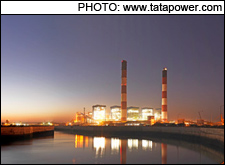 The Government of India has planned thermal power projects with capacity of 72,339 MW, including 3,960 MW in Odisha, during the ongoing 12th Five-Year Plan. The total all-India installed capacity of power generating stations as on March 31, 2013, was 2,23,344 MW and the demand was 1,35,453 MW.
The Government of India has planned thermal power projects with capacity of 72,339 MW, including 3,960 MW in Odisha, during the ongoing 12th Five-Year Plan. The total all-India installed capacity of power generating stations as on March 31, 2013, was 2,23,344 MW and the demand was 1,35,453 MW.
The Ministry of Power aims to meet its capacity addition target through the development of coal-based ultra mega power projects, each with a capacity of 4,000 MW. So far 16 UMPP have been identified in various parts of the country. Out of these, two UMPP are to be located in Tamil Nadu.
In all, four UMPP have been awarded to developers selected through international tariff-based competitive bidding process.
So far, all the units of the 4,000 MW (5×800) Mundra UMPP have been fully commissioned and generating electricity. The plant, located in Kutch district of Gujarat, was awarded to Tata Power Ltd.
Unit-I of Sasan (6×600) UMPP in Singrauli district of Madhya Pradesh, awarded to Reliance Power Ltd, was synchronised in March 2013. Other units of Sasan UMPP are expected to be commissioned during the 12th Plan.
The remaining two ultra mega power projects have also been awarded to Reliance Power Ltd, namely 3,960-MW (6×660) Krishnapatnam in Nellore district of Andhra Pradesh and 3,960-MW (6×660) Tilaiya in Hazaribagh and Koderma districts of Jharkhand. Both these UMPP are likely to be commissioned in the current plan, except for Unit-6 of Tilaiya which is expected to become operational in the 13th Plan.
The government has also planned ultra mega power projects in Odisha, Chhattisgarh, Tamil Nadu, Andhra Pradesh, Jharkhand, Gujarat, Karnataka, Maharashtra and Bihar. These projects are in various stages of development that include the invitation of RfQ for Odisha and Chhattisgarh.
Meanwhile, the Ministry of Power is taking certain other measures to bridge the gap between demand and supply of power, such as, rigorous monitoring of capacity addition of ongoing generation projects; augmentation of domestic manufacturing capacity of power equipment through joint ventures; coordinated operation and maintenance of hydro, thermal, nuclear and gas based power stations for optimal utilisation of existing generation capacity; thrust to import of coal by power utilities to meet the shortfall in coal supplies from indigenous sources; renovation, modernisation and life extension of old and inefficient generation units; and strengthening of interstate and interregional transmission capacity for optimum utilisation of available power.











